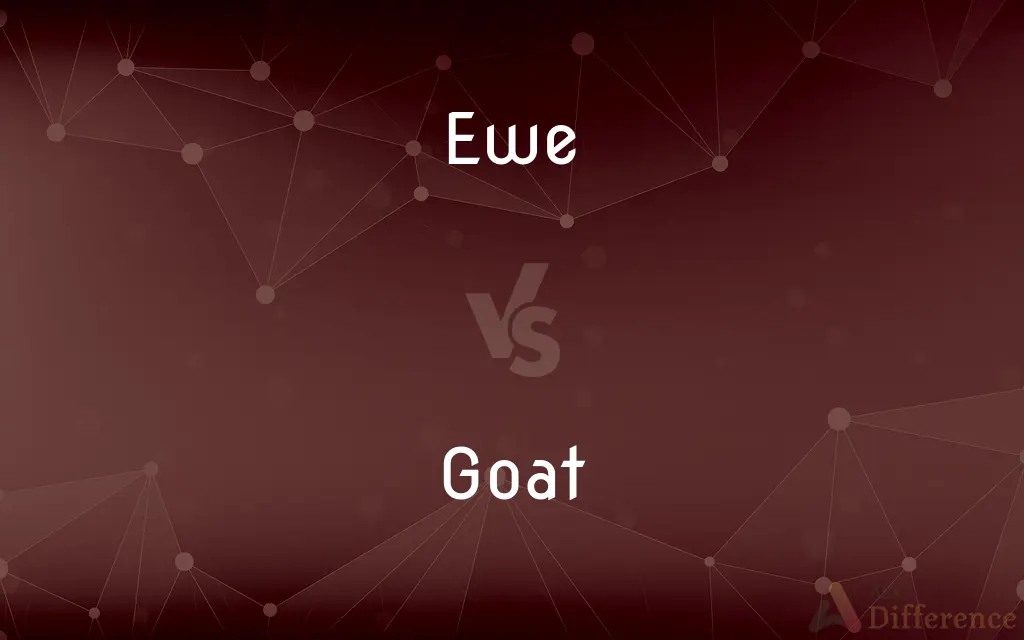Ewe vs. Goat — What's the Difference?
Edited by Tayyaba Rehman — By Fiza Rafique — Updated on April 21, 2024
Ewes are female sheep, known for wool production, while goats are more versatile livestock used for milk, meat, and agility.

Difference Between Ewe and Goat
Table of Contents
ADVERTISEMENT
Key Differences
Ewes are the female counterparts in sheep herds, primarily valued for their ability to produce wool and lambs. Whereas goats are a distinct species, valued for their milk, meat, and often their fiber, showcasing a broader range of uses in agriculture.
Ewes are generally more docile and less curious compared to goats. On the other hand, goats are known for their energetic and sometimes mischievous behavior, which makes them excellent at clearing brush and climbing.
Ewes typically graze on grass, and their grazing pattern is more straightforward and less destructive to the ground. Whereas goats are browsers, often standing on their hind legs to reach leaves, twigs, and vines, which makes them more destructive to foliage.
In terms of social behavior, ewes are known to form strong flocking instincts, which is a defense mechanism against predators. In contrast, goats are more independent and although they can be social, their groups are less tightly knit.
The reproductive behavior of ewes involves seasonal breeding, aligning with specific times of the year for lambing. Meanwhile, goats can breed more flexibly, often capable of producing offspring multiple times a year.
ADVERTISEMENT
Comparison Chart
Species
Ovis aries
Capra aegagrus hircus
Primary Use
Wool and lamb production
Milk, meat, and fiber production
Behavior
Docile and flock-oriented
Independent and curious
Dietary Habits
Grazers, prefer grass
Browsers, prefer varied vegetation
Reproductive Behavior
Seasonal breeding, once a year
More flexible breeding, often biannual
Compare with Definitions
Ewe
Female sheep, especially when fully mature.
The ewe is ready for breeding at about one year of age.
Goat
Exhibits more independent and curious behavior.
The goat escaped the pen to explore the surroundings.
Ewe
Often used in agricultural contexts for wool and meat production.
Shearing the ewes provides wool for making yarn.
Goat
Can be used effectively for brush clearing.
Goats were brought in to clear the overgrown brush on the farm.
Ewe
Generally docile and easy to manage.
The farmer finds the ewes less troublesome than the rams.
Goat
Known for its agility and ability to browse at high levels.
The goat easily navigated the rocky terrain.
Ewe
Shows strong flocking behavior for protection.
The ewe stays close to the flock to avoid predators.
Goat
Breeds more frequently than sheep, often biannually.
Their goats produce kids twice a year.
Ewe
Seasonal breeder with specific lambing seasons.
The ewes are expected to lamb each spring.
Goat
A domesticated animal used for milk, meat, and sometimes fiber.
The goat climbed the tree to reach fresh leaves.
Ewe
A female sheep, especially when full grown.
Goat
The domestic goat or simply goat (Capra aegagrus hircus) is a subspecies of C. aegagrus domesticated from the wild goat of Southwest Asia and Eastern Europe. The goat is a member of the animal family Bovidae and the subfamily Caprinae, meaning it is closely related to the sheep.
Ewe
A member of a people inhabiting southeast Ghana, southern Togo, and southern Benin.
Goat
A hardy domesticated ruminant mammal that has backward-curving horns and (in the male) a beard. It is kept for its milk and meat, and noted for its lively behaviour.
Ewe
The Gbe language of the Ewe people.
Goat
A lecherous man.
Ewe
A female sheep, as opposed to a ram.
Goat
A stupid person; a fool
Just for once, stop acting the goat
Ewe
The female of the sheep, and of sheeplike animals.
Goat
A scapegoat.
Ewe
A member of a people living in southern Benin and Togo and southeastern Ghana
Goat
A domesticated ruminant mammal (Capra hircus) having backward curving horns and a beard especially in the male, raised for its wool, milk, and meat.
Ewe
A Kwa language spoken by the Ewe people in Ghana and Togo and Benin
Goat
Any of various wild ruminant mammals of the genus Capra and related genera, including the ibexes and the wild goat (C. aegagrus) of Eurasia.
Ewe
Female sheep
Goat
A lecherous man.
Goat
A person who is blamed for a failure or misfortune, especially a scapegoat.
Goat
See Capricorn.
Goat
See Capricornus.
Goat
A mammal, Capra aegagrus hircus, and similar species of the genus Capra.
Goat
(uncountable) The meat of the aforementioned animal.
Ugh, we're having goat for dinner again.
Goat
(slang) A lecherous man.
Goat
(informal) A scapegoat.
Goat
(slang) A Pontiac GTO car.
Goat
(speech recognition) A person who is not easily understood by a speech recognition system; contrasted with sheep.
Goat
A fool, loser, or object of ridicule.
Goat
(roller derby) A blocker who is isolated behind the opposing team's blockers, so as to slow down the pack.
Goat
(acronym) Greatest of All Time
Goat
(transitive) To allow goats to feed on.
Goat
(transitive) To scapegoat.
Goat
To isolate (an opposing blocker) behind one's own blockers, so as to slow down the pack.
Goat
A hollow-horned ruminant of the genus Capra, of several species and varieties, esp. the domestic goat (Capra hircus), which is raised for its milk, flesh, and skin.
Goat
Any of numerous agile ruminants related to sheep but having a beard and straight horns
Goat
A victim of ridicule or pranks
Goat
(astrology) a person who is born while the sun is in Capricorn
Goat
The tenth sign of the zodiac; the sun is in this sign from about December 22 to January 19
Common Curiosities
Can ewes and goats be kept together?
Yes, ewes and goats can coexist, but their different dietary and behavioral needs must be managed.
How do the dietary habits of ewes and goats differ?
Ewes are grazers that focus on grass, whereas goats are browsers that prefer a more varied diet including leaves and twigs.
What is the typical breeding cycle for a ewe?
Ewes typically breed seasonally, with lambing usually occurring in the spring.
What is an ewe?
An ewe is a female sheep, typically used for wool and lamb production.
Are ewes or goats more social?
Ewes are more social with strong flocking instincts, while goats are more independent but can still form social groups.
Which is easier to manage, ewes or goats?
Ewes are generally easier to manage due to their docile nature, compared to the more curious and mischievous goats.
What are the environmental impacts of keeping goats?
Goats can be more destructive to vegetation as they tend to browse and can damage trees and shrubs.
What are the primary uses of goats?
Goats are primarily used for their milk, meat, and in some breeds, for their fiber.
How often can goats reproduce?
Goats can reproduce more frequently, often having multiple births in a year.
Why are ewes valued in farming?
Ewes are valued for their wool and lamb production, critical components of female counterpart in sheep herds.
Share Your Discovery

Previous Comparison
Individuality vs. Personality
Next Comparison
Heel vs. JobberAuthor Spotlight
Written by
Fiza RafiqueFiza Rafique is a skilled content writer at AskDifference.com, where she meticulously refines and enhances written pieces. Drawing from her vast editorial expertise, Fiza ensures clarity, accuracy, and precision in every article. Passionate about language, she continually seeks to elevate the quality of content for readers worldwide.
Edited by
Tayyaba RehmanTayyaba Rehman is a distinguished writer, currently serving as a primary contributor to askdifference.com. As a researcher in semantics and etymology, Tayyaba's passion for the complexity of languages and their distinctions has found a perfect home on the platform. Tayyaba delves into the intricacies of language, distinguishing between commonly confused words and phrases, thereby providing clarity for readers worldwide.
















































